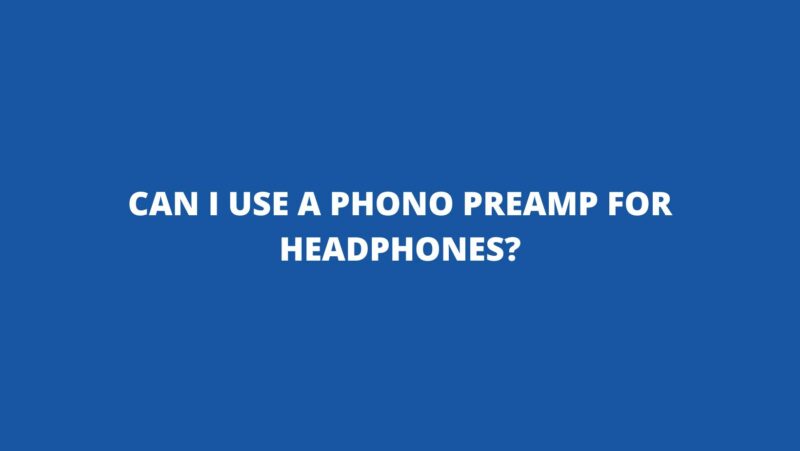In the realm of audio enthusiasts, the pursuit of superior sound quality often leads to unconventional configurations and creative solutions. One intriguing question that arises is whether a phono preamp, typically associated with vinyl record playback, can be repurposed to enhance the audio experience with headphones. This article ventures into the world of sonic experimentation, exploring the feasibility, advantages, and potential limitations of using a phono preamp for headphones. By unraveling the intricacies of this audio endeavor, we aim to provide insights for those seeking innovative ways to elevate their headphone audio journey.
The Phono Preamp Landscape
Before delving into the potential compatibility of phono preamps with headphones, it’s crucial to understand the core function and design of a phono preamp.
Phono Preamp (Preamplifier): A phono preamp is specifically designed to amplify the low-level signal generated by a turntable’s phono cartridge. It corrects the frequency response and equalization to accurately reproduce the music encoded in the vinyl’s grooves. Phono preamps are an essential component in vinyl playback systems, preparing the signal for further amplification by an integrated amplifier or receiver.
Headphone Amp (Amplifier): A dedicated headphone amplifier is engineered to amplify audio signals for headphones, providing the necessary power to drive headphones effectively. These amplifiers enhance sound quality by delivering clean, distortion-free audio with precise volume control and dynamics tailored to the characteristics of headphones.
Can a Phono Preamp be Used for Headphones?
Using a phono preamp for headphones is an intriguing concept, but several factors need to be considered to determine its viability:
- Signal Compatibility: Phono preamps are designed to amplify very low-level signals generated by phono cartridges. These signals have unique characteristics due to the mechanical nature of vinyl playback. In contrast, the line-level signals from typical audio sources (such as CD players or DACs) require different amplification considerations.
- Impedance Matching: Headphones have specific impedance characteristics that require careful matching with the amplifier. Phono preamps are not optimized for driving headphones, which might result in impedance mismatches and suboptimal sound quality.
- Power Output: Dedicated headphone amplifiers are engineered to provide sufficient power to drive headphones with accuracy and detail. Phono preamps might not deliver the necessary power to produce dynamic and impactful headphone sound.
- Equalization and Sound Characteristics: Phono preamps apply specific equalization curves to compensate for the limitations of vinyl records. Repurposing a phono preamp for headphones might result in sound characteristics that are not well-suited for headphone audio.
Potential Advantages and Limitations
Advantages of Using a Phono Preamp for Headphones:
- Sonic Experimentation: Using a phono preamp for headphones can be an avenue for creative sonic exploration, leading to unique tonal qualities and colorations that might appeal to certain listeners.
- Budget Considerations: If you already have a phono preamp and are curious about its potential with headphones, experimenting with this setup could save you from purchasing a dedicated headphone amplifier initially.
Limitations of Using a Phono Preamp for Headphones:
- Sound Quality: Phono preamps are not designed with the characteristics of headphones in mind. Using a phono preamp for headphones might result in compromised sound quality, lacking the precision, power, and dynamics required for accurate headphone audio.
- Impedance and Compatibility: Phono preamps and headphones have different impedance requirements. Attempting to use a phono preamp for headphones might lead to impedance mismatches and suboptimal performance.
- Power and Volume Control: Dedicated headphone amplifiers offer precise volume control and ample power for headphones. A phono preamp might not provide the necessary power to drive headphones effectively, leading to limited volume range and distorted sound.
Conclusion
While the idea of repurposing a phono preamp for headphones is intriguing, the practical limitations and potential compromises in sound quality make it a less-than-ideal solution for serious headphone enthusiasts. Phono preamps are optimized for vinyl playback and have distinct signal characteristics that might not align with the requirements of headphones.
For those seeking the best possible headphone audio experience, investing in a dedicated headphone amplifier is recommended. These amplifiers are designed to deliver the power, precision, and dynamics needed to drive headphones with accuracy and detail. While experimentation is part of the audio journey, it’s essential to prioritize sound quality and compatibility when choosing components for your headphone setup.
In the quest for sonic excellence, dedicated equipment designed to cater to the unique characteristics of headphones will undoubtedly provide a more rewarding and immersive listening experience. By making informed decisions and investing in purpose-built components, you can embark on a headphone audio journey that resonates with the nuances and depth of your favorite music.


